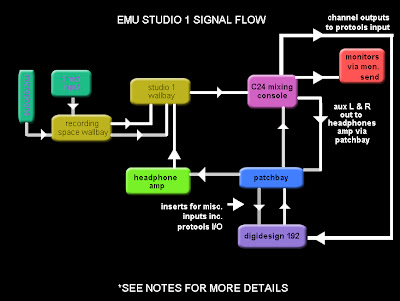This week’s seminar was devoted to listening to one of the lessons from the book (with matching CD) Critical Listening Skills For Audio Professionals, the object of which I presume is to refine our ability to focus our auditory perception to the high levels necessary to make successful audio engineering decisions. We examined variations in level at given frequencies, amongst other things and determined that changes in level are generally more noticeable at lower frequencies and louder (starting) levels. In speech as well as music, 2dB is (for most people) the smallest detectable change in level, which we discovered by listening to endless repeats of the same paragraph of text and the same extract of music. It would have been vastly more entertaining had the reader demonstrated this point by telling a dirty joke and playing fragments of say, The Legendary Stardust Cowboy but I appreciated the lesson nevertheless. It was also postulated that “random noise” can be defined as noise or sound which is constantly shifting in frequency and amplitude and we listened to examples of such with specified centre frequencies. The narrower the bandwidth around that centre frequency, the more “like” that frequency the noise becomes. Sadly, this puts paid to my claim that my bands are all based around random noise.
References
Everest, F. 2006, Critical Listening For Audio Professionals, Course Technology, Boston.
Whittington, S., Concepts of Music (Aural) Seminar (personal notes) 31/07/08
Monday, August 4, 2008
SES WEEK 1 STUDIO 1 SIGNAL FLOW

This week’s exercise involved describing the signal flow from a microphone or DI’d signal in the recording space to Pro Tools in Studio 1. To achieve this I teamed up with Sam Deere and we obtained the necessary information from the EMU (Studio) Guide, Dave Grice during the week 1 seminar and a physical inspection of Studio 1. The assignment also required a description of the talkback, headphones and studio monitors signal flows all of which should be covered by the above diagram. For extra explanatory notes, see below.
Notes:
* Patchbay inputs to Pro Tools are normalised (ie: no patchbay plugs required)
* Pro Tools outputs to patchbay are not normalised and need to be patched (Pro Tools 1 and Pro Tools 2 outputs to C24 Pro Tools source 1 and C24 Pro Tools source 2 inputs)
* For headphones mix, select monitor> auxiliary on C24
* Talkback via desk microphone, automatically patched to headphones (aux) send
* To patch a microphone or DI input via the Avalon pre-amp, the signal path between the microphone inputs at the Studio 1 wallbay is broken by inserting the dedicated Avalon input (mic signal) lead into the signal path or (for a line level signal), plug the instrument directly into the socket on the front panel of the Avalon itself – either of these options will then need to be patched on the patchbay from Avalon Out to ProTools In
References:
D.Grice, EMU Studio 1 Signal Flow, Sound Engineering Studio Lecture, 29/07/08
Adelaide University, Electronic Music Unit, Resources, Guides, Spaces, Studio 1
http://emu.adelaide.edu.au/resources/guides/spaces/studio.1.html, viewed 03/08/08
Subscribe to:
Comments (Atom)
